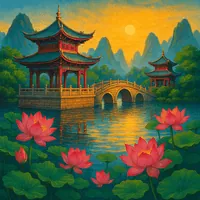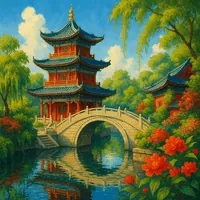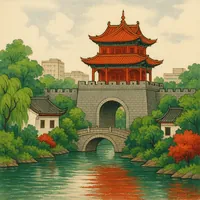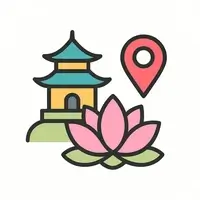


Xingtai, China
Population: 7,111,106
Nestled in Hebei Province, Xingtai thrives as a historical gem with its roots stretching back over 3,500 years. What truly sets Xingtai apart is its reputation as the "Ancient Capital of the Pre-Qin Dynasty," offering a treasure trove of ancient relics and insights into early Chinese civilization. Its fascinating dichotomy of ancient ruins like the expansive Qilihe Site and cutting-edge automotive manufacturing underscores a unique blend of tradition and innovation, unparalleled elsewhere.













Notable points about Xingtai
- Historical Richness: Xingtai is one of China's ancient cities with a history dating back over 3,500 years. It was a significant area during multiple Chinese dynasties, offering history enthusiasts an opportunity to explore well-preserved historical sites and artifacts that showcase its long-standing cultural heritage.
- Unique Geological Formation: The city is known for the Xingtai Basin, a unique geological formation that has played a significant role in the city's development. This basin attracts geologists and researchers from around the world interested in studying its geological characteristics.
- Natural Beauty for Nature Lovers: Xingtai boasts stunning natural landscapes, including the Taihang Mountains. These mountains offer hiking trails with breathtaking views, making it an ideal destination for outdoor enthusiasts and nature lovers.
- Rich Agricultural Output: Known as "The Barn of North China," Xingtai is surrounded by fertile plains that produce a variety of crops, making it an essential contributor to China's agricultural sector. This appeals to those interested in agritourism or the farm-to-table culinary movement.
- Innovative Renewable Energy Initiatives: Xingtai is making strides in renewable energy development, particularly in wind and solar power. This commitment to sustainable energy sets it apart from other Chinese cities and attracts eco-conscious individuals and investors in green technologies.
- Appeal for Families: With its mix of educational institutions and family-friendly parks, Xingtai provides a nurturing environment for families. The city's focus on education and community facilities makes it attractive for those raising children.
- Historic District for Culture Enthusiasts: The Nangong Folk Culture Village offers an immersive experience in traditional Chinese architecture and crafts, providing culture lovers with a deep dive into the ancient craftsmanship and customs unique to the region.
- Economic Growth and Opportunity: Xingtai is emerging as a hub for industrial and economic growth, with a focus on developing sectors such as machinery and mining, offering numerous business and career opportunities for professionals and entrepreneurs.
- Distinctive for Singles: With a thriving cultural scene and a growing number of cafes, bars, and social events, Xingtai offers ample opportunities for singles to mingle and explore new connections in a dynamic urban setting.
- Peaceful Retreat for Seniors: The city's blend of scenic beauty and historical tranquility provides a serene environment for retirees seeking a peaceful lifestyle with ample opportunities for leisurely pursuits and cultural exploration.
Summarized Traveller Reviews
Xingtai's Neighborhoods
Qiaodong District
🎯 Key Attractions
- People’s Park: A sprawling green space where retirees dance and students nap between study sessions.
- Xingtai Grand Theater: Modern venue hosting traditional opera, touring dance troupes, and awkward award ceremonies.
- Midnight Mahjong Bazaar: An unofficial gathering of locals who treat tiles like sacred relics under flickering neon lights.
✨ Unique Aspects
This district boasts a curious mix of polished civic buildings and rowdy street vendors yelling about tofu skins like it’s a sport.
Qiaoxi District
🎯 Key Attractions
- Kaiyuan Temple Ruins: A poignant fragment of Xingtai’s Buddhist heritage nestled between apartment towers.
- Xingtai Museum: Modest but rich in ancient pottery, war drums, and stories the guides secretly improve on.
- The Echo Noodle Shop: A noodle stall said to remember your order after one visit—or one heartbreak.
✨ Unique Aspects
The area’s soul lies in its contradictions: decaying temples beside glass banks, and one-legged pigeons that always find your bench.
Renxian County
🎯 Key Attractions
- Renxian Ancient City Wall: Crumbled earth walls that whisper of a thousand forgotten border skirmishes.
- Chrysanthemum Lane: A seasonal flower alley that blooms like gossip, only louder.
- Stubborn Goose Café: A teahouse run by a retired engineer who serves poetry with every thermos.
✨ Unique Aspects
Perfect for long walks, not-so-perfect for taxis—bring snacks and existential questions.
Nangong City
🎯 Key Attractions
- Nangong Textile Museum: Spindles, silk, and a surprisingly emotional exhibit on socks.
- Workshop District 17: Converted factory spaces now housing microbreweries, muralists, and unseasoned jazz bands.
- Whispering Bobbin Lane: An alley where every door has a story—and a stray cat with an opinion.
✨ Unique Aspects
The vibe’s part faded industrial glory, part soft revolution—like your granddad suddenly wearing Vans.
Shahe City
🎯 Key Attractions
- Shahe Glass Market: A shimmering labyrinth of mirrors, glass panels, and deals shouted like prayers.
- Glass Culture Park: Hands-on experiences in stained glass-making, if you trust yourself with breakables.
- The Invisible Café: Walls made of tempered glass. Good luck finding the entrance—but once you do, the view’s weirdly peaceful.
✨ Unique Aspects
The entire neighborhood glints with industry and ambition—just don’t forget your sunglasses or humility.
Linxi County
🎯 Key Attractions
- Ancient Scholar’s Path: An old stone trail once used by imperial exam takers—now great for moody strolls.
- Inkstone Pavilion: Traditional brush art exhibits and occasional haiku battles.
- Lantern Lake: Said to reflect your past life if you stare too long. Locals dare you.
✨ Unique Aspects
The air here feels older than the trees, and the locals speak softly, like they’re in on something eternal.
Ningjin County
🎯 Key Attractions
- Ningjin E-Commerce Park: Warehouses, start-ups, and the occasional drone flying just low enough to freak you out.
- Code & Congee Café: Developers debug between bowls—think Silicon Valley but with chili oil.
- Vanishing Mailbox Installation: An interactive art piece that erases your postcards over time. Metaphor much?
✨ Unique Aspects
Feels like a beta version of tomorrow, still glitchy but optimistic.
Guangzong County
🎯 Key Attractions
- Guangzong Confucian Temple: A quiet complex echoing with the footsteps of centuries of thinkers.
- Drifting Market: A nomadic bazaar that appears by dusk and dissolves by sunrise.
- The Listening Wall: Locals believe the wall whispers old secrets if you lean in—and you’re very, very still.
✨ Unique Aspects
This county doesn’t entertain time—it converses with it.
Wei County
🎯 Key Attractions
- Wei Opera Academy: Training ground for Xingtai’s traditional performers—voices here echo through your bones.
- Rebellion Square: Monuments and murals celebrating historical uprisings—and chicken feet vendors.
- The Curtain Café: Each table has its own tiny stage; your tea arrives with fanfare and a bow.
✨ Unique Aspects
Where every meal could be a performance, and every elder has a story involving a blade.
Neiqiu County
🎯 Key Attractions
- Baiyun Mountain Scenic Area: Hiking trails, cliffside temples, and one very photogenic pine tree.
- Ancient Bandit Bridge: An old crossing where travelers once had to pay with coins—or poems.
- Peach Thief Trail: A hidden path where blossoms fall like pink snow. No actual thieves, probably.
✨ Unique Aspects
Feels like stepping into a poem written by someone who’s seen too many sunrises.




































































































